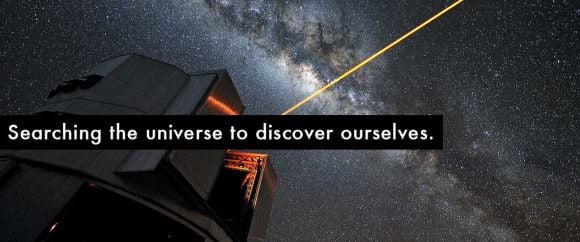The 'Language in the Cosmos' symposium
Three times in October, 2017 researchers turned a powerful radar telescope near Tromsø, Norway towards an invisibly faint star in the constellation Canis Minor (the small dog) and beamed a coded message into space in an attempt to signal an alien civilization. This new attempt to find other intelligent life in the universe was reported in a presentation at the 'Language in the Cosmos' symposium held on May 26 in Los Angeles, California.
METI International
sponsored the symposium. This organization was founded to promote messaging to extraterrestrial intelligence (METI) as a new approach to in the search for extraterrestrial intelligence (SETI). It also supports other aspects of SETI research and astrobiology. The symposium was held as part of the
International Space Development Conference
sponsored by the
National Space Society
. It brought together linguists and other scientists for a daylong program of 11 presentations.
Dr. Sheri Wells-Jensen
, who is a linguist from Bowling Green State University in Ohio, was the organizer.
[caption id="attachment_129104" align="alignright" width="580"]
METI International[/caption]
This is the second of a two part series
about METI International's symposium. It will focus on a presentation given at the symposium by the president of METI International,
Dr. Douglas Vakoch
. He spoke about a project that hasn't previously gotten much attention: the first attempt to send a message to a nearby potentially habitable exoplanet, GJ273b. Vakoch led the team that constructed the tutorial portion of the message. [caption id="attachment_139389" align="aligncenter" width="300"]
Dr. Douglas Vakoch, president of METI International. (Credit: Per Bifrost public domain)[/caption]
Message to the stars
The modern search for extraterrestrial intelligence began in 1960. This is when astronomer
Frank Drake used a radio telescope in West Virginia
to listen for signals from two nearby stars. Astronomers have sporadically mounted increasingly sophisticated searches, when funding has been available. The largest current project is
Breakthrough Listen
, funded by billionaire Yuri Milner. Searches have been made for laser as well as radio signals. Researchers have also looked for the megastructures that advanced aliens might create in space near their stars. METI International advocates an entirely new approach in which messages are transmitted to nearby stars in hopes of eliciting a reply.
The project to send a message to GJ273b was a collaboration between artists and scientists. It was initiated by the organizers of the
Sónar Music, Creativity, and Technology Festival
. The Sónar festival has been held every year since 1994 in Barcelona, Spain. The organizers wanted to commemorate the 25th anniversary of the festival. To implement the project, the festival organizers sought the help of the
Catalonia Institute of Space Studies (IEEC)
, and METI International. [caption id="attachment_139390" align="aligncenter" width="580"]
The Sónar Music, Creativity, and Technology Festival of Barcelona, Spain was a sponsor of the message to GJ273b.[/caption] To transmit the message, the team turned to The
European Incoherent Scatter Scientific Association (EISCAT)
which operates a network of radio and radar telescopes in Finland, Norway, and Sweden. This network is primarily used to study interactions between the sun and Earth's ionosphere and magnetic field from a vantage point north of the arctic circle. The message was transmitted from a 32 meter diameter steerable dish at EISCAT's Ramfjordmoen facility near Tromso, Norway, with a peak power of 2 megawatts. It is the first interstellar message ever to be sent towards a known potentially habitable exoplanet.
The target system
The obscure star known by the catalogue designation GJ273 caught the attention of the Dutch-American astronomer
Willem J. Luyten
in 1935. Luyten was researching the motions of the star. The star caught his attention because it was moving through Earth's sky at the surprising rate of 3.7 arc seconds per year. Later study showed that this fast apparent motion is due to the fact that GJ273 is one of the sun's nearest neighbors, just 12.4 light years away. It is the 24th closest star to the sun. Because of Luyten's discovery it is sometimes known as
Luyten's star
.
Luyten's star is a faint red dwarf star with only a quarter of the sun's mass. It caught astronomers' attention again in March 2017. That's when an exoplanet,
GJ273b
, was discovered in it's habitable zone. The habitable zone is the range of distances where a planet with an atmosphere similar to Earth's would, theoretically, have a range of temperatures suitable to have liquid water on its surface. The planet is a super Earth, with a mass 2.89 times that of our homeworld. It orbits just 800,000 miles from its faint sun, which it circles every 18 Earth days. [caption id="attachment_139391" align="aligncenter" width="580"]
Artist's impression of a habitable exoplanet orbiting a red dwarf star. The habitability of the planets of red dwarf stars is conjectural (Credit ESO/M. Kornmesser public domain)[/caption] This exoplanet was chosen because of its proximity to Earth, and because it is visible in the sky from the transmitter's northerly location. Because GJ273b is relatively nearby, and radio messages travel at the speed of light, a reply from the aliens could come as early as the middle of this century.
The Message
Comparisons with Voyager
The GJ273b transmission is
not the first time a message intended for extraterrestrials has been sent into space
. Probably the most familiar interstellar message is the one carried on board the Voyager 1 and 2 spacecraft. NASA launched these interplanetary robots in 1977. They traveled on trajectories that hurtled them into interstellar space after they completed their missions to explore the outer solar system.
The
message carried aboard each Voyager spacecraft
was encoded digitally on a phonographic record. It was largely pictorial, and attempted to give a comprehensive overview of humans and Earth. It also included a selection of music from various Earthly cultures. These spacecraft will take tens of thousands of years to reach the stars. So, no reply can be expected on a timescale relevant to our society.
In some ways the GJ273b message is very different from the Voyager message. Unlike the Voyager record, it isn't pictorial and doesn't attempt to give a comprehensive overview of humans and Earth. This is perhaps because, unlike the Voyager message, it is intended to initiate a dialog on a timescale of decades. It resembles the Voyager message in that it contains music from Earth, namely, music from the artists that performed at the Sónar music festival.
Saying hello
For the human reader, understanding the message is a bit more of a challenge than
looking at the pictures encoded on the Voyager record
. You can try your hand at decoding the message yourself, because
the organizers posted the whole thing on their website
. Be forewarned that if you continue reading here, there are spoilers (or helpful clues, depending on how you look at it).
The message consists of a string of binary digits—ones and zeros. These are represented in the signal by a shift between two slightly different radio frequencies. The 'hello' section is designed to catch the attention of alien listeners. It consists of a string of prime numbers (numbers divisible only by themselves and one). They are represented with binary digits like this:
01001100011100000111110000000000011111111111
The message continues the sequence up to 193. A signal like this almost certainly can't be produced by natural processes, and can only be the designed handiwork of beings who know math.
The tutorial
After the 'hello' section comes the tutorial. This, and all the rest of the message, uses eight bit blocks of binary digits as the basis for its symbols. The tutorial begins by introducing number symbols by counting. It uses base two numbers like this:
10000000 (0) 10000001 (1) 10000010 (2) 10000011 (3)
 Universe Today
Universe Today




